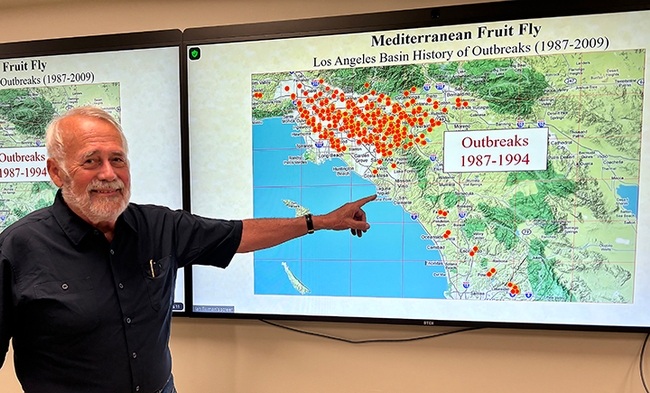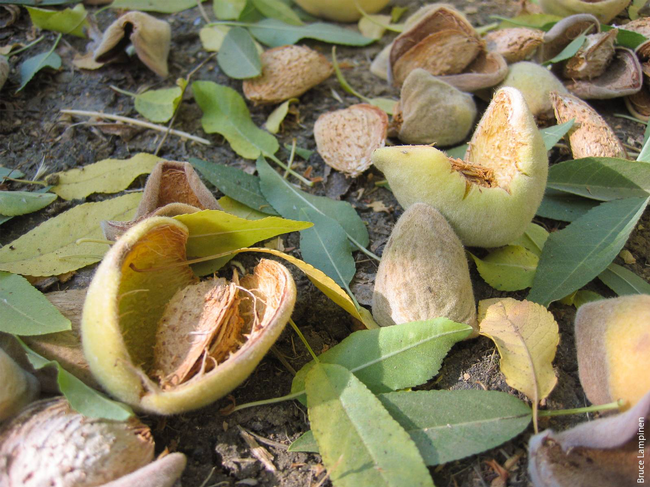Posts Tagged: food
Entomologist Lynn Kimsey in Video Tribute Celebrating Newest UC Davis Emeriti
UC Davis distinguished professor emerita Lynn Kimsey, director of the Bohart Museum of Entomology for 34 years until her retirement on Feb....

UC Davis distinguished professor Lynn Kimsey is featured in the newest UC Davis video tribute to emeriti, a public service project of UC Davis distinguished professor Walter Leal.
Children's Party at the Vacaville Museum: A Honey of an Event
The Vacaville Museum Guild's annual children's party--for Vacaville children ages 3 to 9--promises to be a honey of a party. Themed "Fun...

This is the bee observation hive that Ettamarie Peterson, known as the "Queen Bee of Sonoma County," will display at the children's party.

Ettamarie Peterson stands by "Miss Bee Haven," a six-foot ceramic-mosaic sculpture at the UC Davis Bee Haven. The sculpture is the work of Davis artist Donna Billick. (Photo by Kathy Keatley Garvey)

Amina Harris, founding director and emerita of the UC Davis Honey and Pollination Center, stands inside her family's business, The Hive, a community gathering place in Woodland that offers honey and mead tasting.

Be a butterfly! Professor Fran Keller of Folsom Lake College, a UC Davis doctoral alumna and Bohart Museum scientist, poses as a butterfly. She wrote a children's book on the California dogface butterfly that is available in the Bohart Museum gift shop. (Photo by Kathy Keatley Garvey)
New project aims to use farm waste to fuel bioeconomy
UC ANR to help create database, support technology for sustainable bioproducts and biofuels
In California's Northern San Joaquin Valley, crop leftovers such as almond shells, fruit peels and orchard trimmings can potentially be converted into sustainable bioproducts and biofuels – with the right technology. The philanthropy Schmidt Sciences' Virtual Institute on Feedstocks of the Future, which supports replacing fossil feedstocks with renewable biomass sources, has awarded new funding to a group investigating how to make better use of the diverse agricultural waste in the region.
“This is an important project for California as it quantifies the diverse ‘ingredients' in the North San Joaquin Valley available to fuel the emerging biomanufacturing industry in the state,” said Gabe Youtsey, chief innovation officer for the University of California Agriculture and Natural Resources. “This foundational work will kickstart a completely new innovation bioeconomy in the Central Valley that will create new high-paying jobs for our communities and support a resilient food and agriculture industry through circular biomanufacturing.”
Circular biomanufacturing is a process that uses waste streams as raw materials to create new products.
“Circular means taking waste streams from agriculture such as almond shells or grape pomace, forest waste or food processing waste and using that material as the ‘feedstock' in a fermentation tank to create new bioproducts,” Youtsey explained.
The group, “Building the Circular Bioeconomy in the North San Joaquin Valley” or BioCircular Valley, is co-led by the Department of Energy's Lawrence Berkeley National Laboratory (Berkeley Lab), UC Berkeley, and BEAM Circular, with partners at UC Merced, UC Agriculture and Natural Resources, the Almond Board of California and USDA Agricultural Research Station in Albany.
“California has this incredible diversity of materials, but they aren't well understood – and this makes it difficult to know how to extract the most value out of them,” said Corinne Scown, a senior scientist at Berkeley Lab and UC Berkeley and one of the project leads. “We want to characterize them and make that information available so companies can more easily figure out which feedstock is a good match for them, and then use that agricultural residue to make everything from bio-based polymers and chemicals to sustainable materials and aviation fuels.”
One of the group's goals is to build a publicly accessible database and user-friendly map full of information about different feedstocks, the raw plant materials and biomass that can be broken down and used to make bioproducts. That includes where feedstocks are located, when they are available, how they are currently disposed of, how they perform in different bioreactors, how much sugar or lignin they contain, whether they can be processed with other feedstocks, their greenhouse gas footprint, the potential cost, and much more.
UC ANR's role is to collect data on available feedstocks from forest, agricultural and food processing byproducts, as well as municipal waste streams through sampling and observation.
“We will do this through the extensive knowledge and relationships we have with the California agriculture industry in the North San Joaquin Valley,” Youtsey said. “UC ANR will also support industry outreach as new ‘conversion' technologies are developed, to pilot them with California growers and processors.”
The project will also test ways to improve the flexibility of the conversion process, which breaks down feedstocks to prepare them to make bioproducts. Researchers will apply artificial intelligence to their lab-generated data to improve predictions of how feedstocks can be processed most efficiently or blended together. Being able to use the same technique on different (or mixed) kinds of plant matter would open up ways for companies to make bioproducts more easily.
“Our region has a fantastic combination of diverse and large-scale agricultural activities alongside manufacturing expertise, making this a great place to scale up bioeconomy innovation,” said Karen Warner, CEO of BEAM Circular. “This project will allow us to reduce barriers to using our region's abundant waste streams in more sustainable and valuable ways, so that we can create the products that people need with renewable inputs that are better for the planet.”
The project builds on ongoing efforts to establish biomanufacturing capabilities in the northern San Joaquin Valley, which includes San Joaquin, Stanislaus and Merced counties. Providing better data on how to convert the valley's millions of tons of agricultural waste into valuable products may spur biomanufacturing companies to build facilities nearby, minimizing how far the raw materials have to be moved and generating new jobs.
“This project is designed to benefit a region that has massive potential, but so far has been economically left behind, and to develop a new industry that can provide improvements in air quality, water quality and greenhouse gas emissions as well as significant opportunities in economic equity and the creation of new jobs,” said Blake Simmons, director of Berkeley Lab's Biological Systems and Engineering Division and the BioCircular Valley project lead.
“This kind of research started as basic science, and now we're bringing information and solutions to people who can use them. And the knowledge generated through this project will advance not only the ability of the NSJV to make use of its own regionally available future feedstocks, but will also accelerate the understanding of feedstocks relevant across California and across the U.S.”
The new funds for the project come from the Virtual Institute on Feedstocks of the Future, a partnership between Schmidt Sciences and the Foundation for Food & Agriculture that supports collaboration on research to transform biomass into alternative feedstocks for biomanufacturing. The award is one of five announced today, which total $47.3 million over five years. It is expected that the five teams will collaborate to share best practices and knowledge to boost the bioeconomy at the national level.
“We are grateful for Schmidt's generous support that will help deploy advanced technologies on the ground,” said Alicia Chang, interim president of Berkeley Lab Foundation. “The foundational research and expertise developed through work for the Department of Energy sets the stage for this team to apply their capabilities to bring jobs and lift the community and the economy in the Northern San Joaquin Valley.”
Why Soldier Beetles Deserve the Aphid Belt
It's the Fourth of July and what better time to post images of the aptly name "soldier beetles" than today. These insects (family Cantharidae)...

It's early morning, and a soldier beetle stirs in a Vacaville garden. A beneficial insect, it eats aphids and other soft-bodied insects. (Photo by Kathy Keatley Garvey)

Are the Red Coats coming? No, but this soldier beetle is alert. (Photo by Kathy Keatley Garvey)
Carey Engages Audience in California's Fruit Fly Crisis
If you missed UC Davis distinguished professor James R. Carey's well-attended seminar on "California's Fruit Fly Invasion: A 70-Year...

UC Davis distinguished professor James R. Carey presented a seminar on "California's Fruit Fly Invasion: A 70-Year Struggle Nears Critical Mass" on June 3 in Briggs Hall, UC Davis campus, and on Zoom. (Photo by UC Davis distinguished professor Walter Leal)


